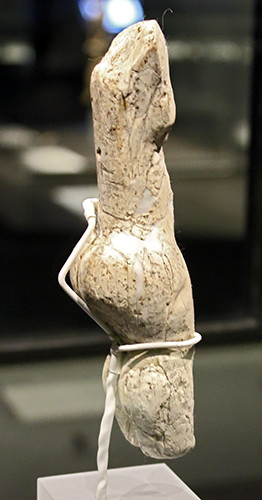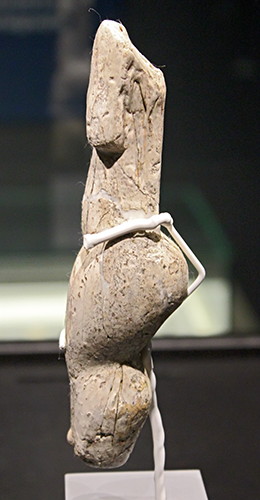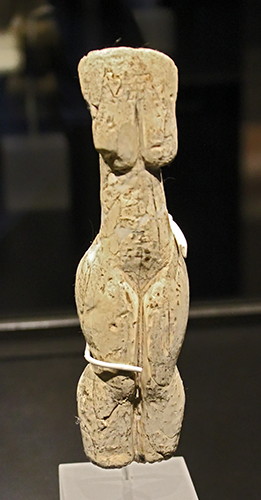Back to Don's Maps
Back to Venus figures from the Stone Age
Venus figures from Russia, Ukraine and sites East of the Donau mouth
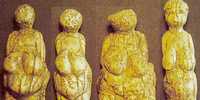 Avdeevo - Venus figures and other finds from this important archaeological site.
Avdeevo - Venus figures and other finds from this important archaeological site.
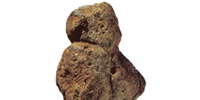
The female figurine from Berekhat Ram, in Israel is one of the oldest known figurative carvings in the world, and is somewhere between 250 000 and 280 000 years old, older than Neanderthal man, and probably carved by Homo Erectus. The original pebble bore a resemblance to a female, and this was enhanced by the carver, who cut grooves around the neck and along its arms. Microscopic analysis by Alexander Marshack has now made it clear that humans were responsible.
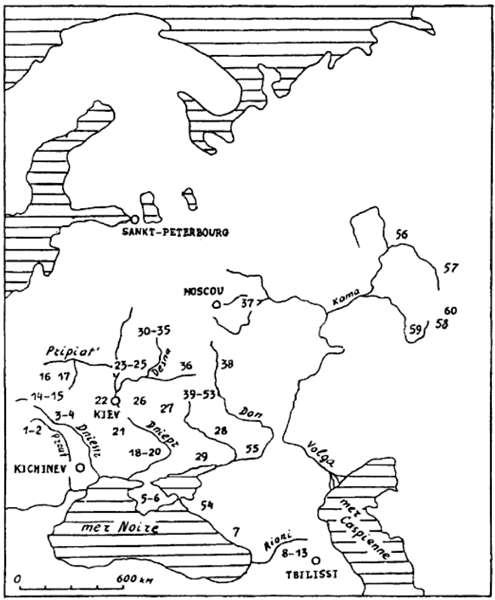
Distribution of mobile art in Eastern Europe.
1 Staryé Duruitory, 2 Brynzeny, 3 Kosseoutzy, 4 Klimaoutzy, 5 Suren' 1, 6 Chan-Koba, 7 Apiantcha, 8 grotte d'Uvarov, 9 Sakagia, 10 Sagvardgilé, 11 Gvardgilas-Kldé, 12 Devis-Khvreli, 13 Taro-Kldé, 14 Molodova V, 15 Lissitchniki, 16 Lipa VI, 17 Klinetz, 18 Ossokorovka, 19 Dubovaya Balka, 20 Kaïstrovaya Balka, 21 Mejiritch (Mezhirich), 22 Kievo-Kirillovskaya, 23 Mézine (Mizyn), 24 Novgorod Severskyi, 25 Puchkari I, 26 Dobranitchevka, 27 Gontzy, 28, Rogalik, 29 Amvrossievka, 30 Eliseevitchi I, 31 Eliseevitchi II, 32 Yudinovo, 33 Khoylevo II, 34 Timonovka, 35 Suponevo, 36 Avdeevo, 37 Sungir', 38 Gagarino, 39 Kostienki 19, 40 Kostienki 21, 41 Kostienki 13, 42 Kostienki 1, 43 Kostienki 14, 44 Kostienki 12, 45 Kostienki 17, 46 Kostienki 2, 47 Kostienki 11, 48 Kostienki 4, 49 Kostienki 15, 50 Kostienki 9, 51 Kostienki 8, 52 Borchtchevo 1, 53 Borchtchevo 2, 54 Ilskaya, 55 Murakovka, 56 Ostrovskaya, 57 Bez'imyannyi, 58 Smelobskaya, 59 Kapova, 60 Ignatievskaya.
Photo: Abramova (1995)
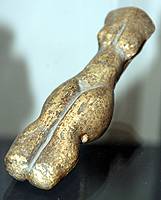
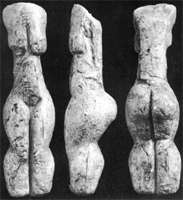
The Yeliseevichi venus figure.
From: www.folklore.ee/folklore/vol18/pa04.pdf
The Yeliseevichi site was discovered in 1930 and it is located on the river Sudost, the right tributary of the Desna, in the Briansk Province, Russia. The majority of prehistoric artefacts was found in a heap of mammoth skulls piled next to a residential house. The most remarkable of these is a finely modelled 15 cm tall figure depicting a shapely woman with no feet, head and hands, carved of mammoth tusk. The figurine has prominent buttocks and legs.
(This venus figure, represented by facsimiles in these photos, appears never to have had a head, and the sculpture emphasises the thighs and buttocks rather than the breasts, although they are certainly indicated. This has the look of a younger figure which has not yet gone through childbirth. The waist is slim, the hips and thighs are well formed, as are the breasts, unchanged by child-rearing. It has quite a different emphasis and seems from a different tradition when compared with most other Kostenki venuses, nor for that matter with most of the other Gravettian venuses from France, for example. It has affinities with the unusual "venus impudique" from France. - Don)
Photo (left): Vladimir Gorodnjanski, 2006
Photo (right): www.folklore.ee/folklore/vol18/pa04.pdf
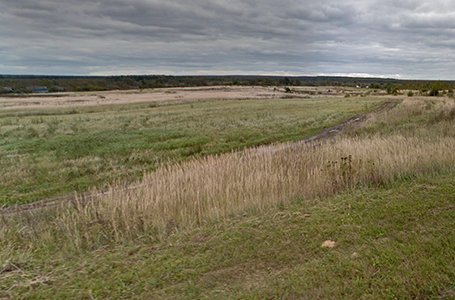
The wide and shallow valley of the Sudost River.
Shown here from the road through Yeliseyevichi, Eliseevichi, Елисеевичи, Bryansk Oblast, Russia, population 24.
Photo: © Google Maps/Street view
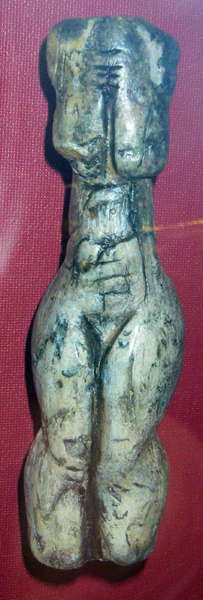
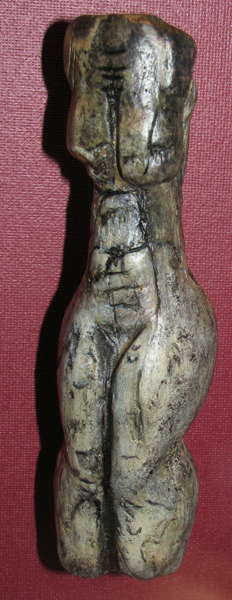
The Yeliseevichi venus figure.
Photo: Don Hitchcock 2008
Source: Facsimile, Vienna Natural History Museum
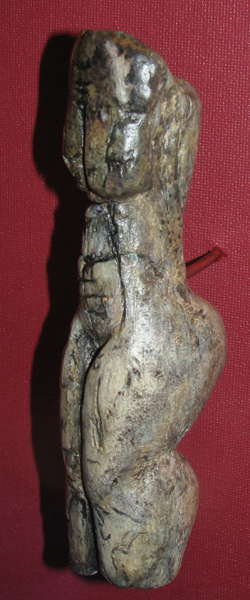
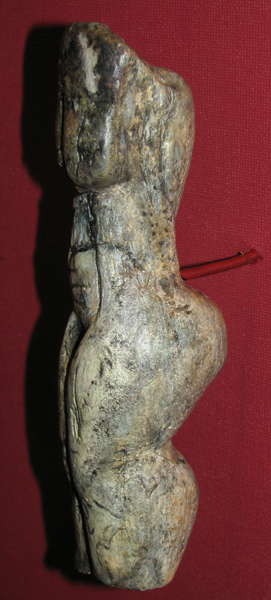
The Yeliseevichi venus figure.
Photo: Don Hitchcock 2008
Source: Facsimile, Vienna Natural History Museum
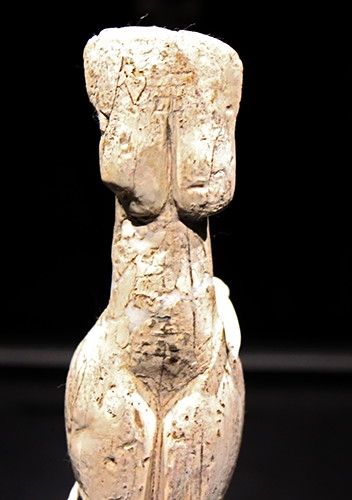
The Yeliseevichi venus figure.
Photo: Ralph Frenken
Source: original, exhibited at the Archeological Museum Hamburg (Ice Age - The Art of the Mammoth Hunters from 18 October 2016 to 14 May 2017)
On loan from the Hermitage Museum, Saint Petersburg, Russia.
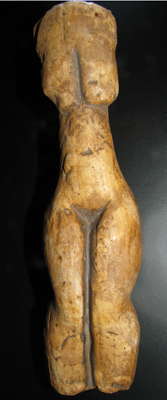
The Yeliseevichi venus figure.
Photo: Don Hitchcock 2008
Source: Facsimile, Venusium Museum at Willendorf, Austria.

ЖЕНСКАЯ СТАТУЭТКА
бивень мамонта Елисеевичи, Брянская область (15-16 тыс. лет), муляж
Эта женская статуэтка скорее исключение, чем правило для эпохи каменного века. Ее моделью скорее была молодая, еще не рожавшая женщина, судя по ее плоскому животу. Выпадая из общего канона женских изображений каменного века, эта статуэтка говорит о реализме искусства того времени - перед нами вырисовывается вереница женских образов, моделями которым служили конкретные женщины той далекой поры.
Mammoth tusk, Eliseevich, Bryansk region (15-16 BP), facsimile.
This female figurine is the exception rather than the rule for the Stone Age.
The model for the figurine is a young woman who has not yet given birth, judging from her flat stomach. Outside of the general canon of female images of the stone age, this figurine shows the realism of some art of that time, and is modelled on a specific woman of that distant time.
Photo: Vladimir Gorodnjanski 2014
Source and text: Facsimile, Kostenki Museum

This bear bone from Yeliseevichi is decorated with regular engravings.
Photo: Ralph Frenken
Source: Original, exhibited at the Archeological Museum Hamburg (Ice Age - The Art of the Mammoth Hunters from 18 October 2016 to 14 May 2017)
On loan from the Hermitage Museum, Saint Petersburg, Russia.
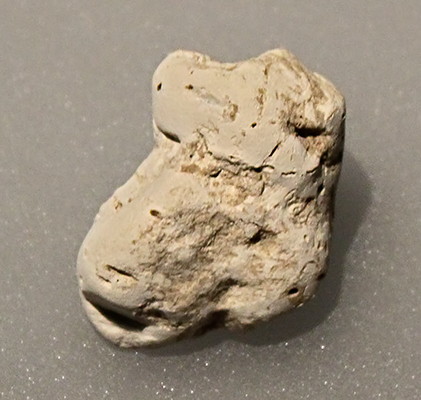
This head of pale limestone from Yeliseevichi has eyes and a mouth. It is assumed that it is a mixture of animal and man.
Photo: Ralph Frenken
Source: Original, exhibited at the Archeological Museum Hamburg (Ice Age - The Art of the Mammoth Hunters from 18 October 2016 to 14 May 2017)
On loan from the Hermitage Museum, Saint Petersburg, Russia.
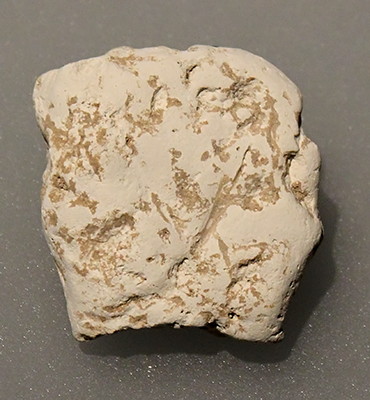
Also of limestone is this small plate from Yeliseevichi on which presumably an incised triangle and a point represent a vulva.
Photo: Ralph Frenken
Source: Original, exhibited at the Archeological Museum Hamburg (Ice Age - The Art of the Mammoth Hunters from 18 October 2016 to 14 May 2017)
On loan from the Hermitage Museum, Saint Petersburg, Russia.
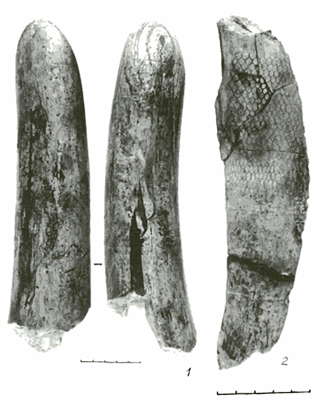
Yeliseevichi / Eliseevitchi decorated fragment of a mammoth tusk and decorated plaque.
( A better image of the right hand mammoth tusk appears immediately below - Don )
Photo: Abramova (1995)
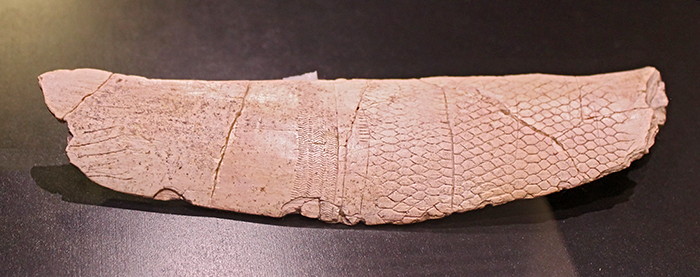
Yeliseevichi / Eliseevitchi, 15 000 BP.
The engravings and the outline of this figure made of mammoth ivory give the impression of a freshwater fish. There are clearly scales and the tail fin can be seen.
In addition to these true to life features, there are also incised geometric zigzag decorations on the object.
Photo: Ralph Frenken
Source: Original, exhibited at the Archeological Museum Hamburg (Ice Age - The Art of the Mammoth Hunters from 18 October 2016 to 14 May 2017)
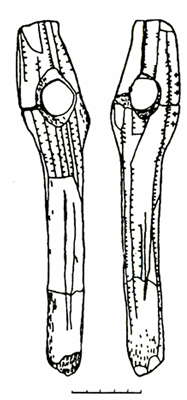
Yeliseevichi / Eliseevitchi decorated pierced baton or spear straightener.
Photo: Abramova (1995)
References
- Abramova Z., 1995: L'Art paléolithique d'Europe orientale et de Sibérie., Grenoble: Jérôme Millon.
- Cohen C., 2003: La femme des origines. Images de la femme dans la préhistoire occidentale,, Paris, Belin-Herscher, 2003, 191 pages.
- D'Errico F., Nowell A., 2003: La femme des origines. Images de la femme dans la préhistoire occidentale,, Paris, Belin-Herscher, 2003, 191 pages.
- D'Errico F., Nowell A., 2009: On the Origin of Art and SymbolismScienceVol 323 6 February 2009
- Sklenar, Karel, 1988: Hunters of the Stone Age, illustrated by Pavel Dvorsky and Eliska Sklenarova, Heinemann Publishers Australia, 1988
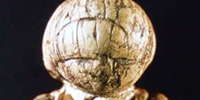
 Mal'ta venuses - the site of Mal'ta, for which the culture is named, is composed of a series of subterranean houses made of large animal bones and reindeer antler which had likely been covered with animal skins and sod to protect inhabitants from the severe, prevailing northerly winds. Among the artistic accomplishments evident at Mal'ta are remains of expertly carved bone, ivory, and antler objects. Figurines of birds and human females are the most commonly found items.
Mal'ta venuses - the site of Mal'ta, for which the culture is named, is composed of a series of subterranean houses made of large animal bones and reindeer antler which had likely been covered with animal skins and sod to protect inhabitants from the severe, prevailing northerly winds. Among the artistic accomplishments evident at Mal'ta are remains of expertly carved bone, ivory, and antler objects. Figurines of birds and human females are the most commonly found items. 
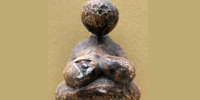 The Gagarino venus which is most well known is of an obese woman from the Gagarino site, located on the right bank of the Don River near the Sosna tributary. Here peasants discovered a house pit while excavating a silo trench. Zamiatinine, who excavated this site during 1926 - 1929, found a house pit roughly oval in outline about 5.5 metres long and 4.5 metres wide. The wealth of material remains found in this one house pit is seen in the recorded finds of some six hundred flint implements, over a thousand blades, and proportionately large numbers of cores and waste flints. Artefacts of bone as well as seven 'venus' figurines completed the roster of non-lithic material.
The Gagarino venus which is most well known is of an obese woman from the Gagarino site, located on the right bank of the Don River near the Sosna tributary. Here peasants discovered a house pit while excavating a silo trench. Zamiatinine, who excavated this site during 1926 - 1929, found a house pit roughly oval in outline about 5.5 metres long and 4.5 metres wide. The wealth of material remains found in this one house pit is seen in the recorded finds of some six hundred flint implements, over a thousand blades, and proportionately large numbers of cores and waste flints. Artefacts of bone as well as seven 'venus' figurines completed the roster of non-lithic material.
